Studies in the Dead Sea Scrolls and Related Literature Series (11 vols.)
Digital Logos Edition
Overview
The Dead Sea Scrolls have been the object of intense interest in recent years, not least because of the release of previously unpublished texts from Qumran Cave 4 since the fall of 1991. With the wealth of new documents that have come to light, the field of Qumran studies has undergone a renaissance. Scholars have begun to question the established conclusions of the last generation: some widely held beliefs have withstood scrutiny, but others have required revision or even dismissal. New proposals and competing hypotheses, many of them of an uncritical and sensational nature, vie for attention. Idiosyncratic and misleading views of the Scrolls still abound, especially in the popular press, while the results of solid scholarship have yet to make their full impact. At the same time, the scholarly task of establishing reliable critical editions of the texts is nearing completion. The opportunity is ripe, therefore, for directing renewed attention to the task of analysis and interpretation. And, Studies in the Dead Sea Scrolls and Related Literature Series (11 Vols.) is a collection designed to address this need.
In particular, the series aims to make the latest and best Dead Sea Scrolls scholarship accessible to scholars, students, and the thinking public. The volumes that are projected—both monographs and collected essays—will seek to clarify how the Scrolls revise and help shape our understanding of the formation of the Bible and the historical development of Judaism and Christianity. Various offerings in the series will explore the reciprocally illuminating relationships of several disciplines related to the Scrolls, including the canon and text of the Hebrew Bible, the richly varied forms of Second Temple Judaism, and the New Testament. While the Dead Sea Scrolls constitute the main focus, several of these studies will also include perspectives on the Old and New Testaments and other ancient writings—hence the title of the series. It is hoped that these volumes will contribute to a deeper appreciation of the world of early Judaism and Christianity and of their continuing legacy today.

- Writings from dozens of well-known theologians and biblical scholars
- Important works on the subject of the Dead Sea Scrolls
- Perfect for pastors, teachers, students, and laity
- Title: Studies in the Dead Sea Scrolls and Related Literature Series
- Publisher: W. B. Eerdmans
- Volumes: 11
- Pages: 3,019
This title is included in the following collections
You can save when you purchase this product as part of a collection.
2025 Researcher Diamond Librar...
$2,999.99$2,249.992025 Messianic Jewish Diamond
$2,999.99$2,249.992025 Orthodox Diamond
$2,999.99$2,249.992025 아카데믹 다이아몬드 서재
$3,149.99$2,362.49
- $4,749.99$3,562.49
- $4,749.99$3,562.49
- $4,749.99$3,562.49
- $4,899.99$3,674.99
- $23,999.99$17,999.99
- $37,403.33$27,999.99
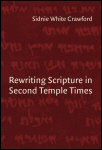
The biblical manuscripts found at Qumran, contends Sidnie White Crawford, reflect a spectrum of text movement from authoritative scriptural traditions to completely new compositions. Treating six major groups of texts, she shows how differences in the texts result from a particular understanding of the work of the scribe—not merely to copy but also to interpret, update, and make relevant the Scripture for the contemporary Jewish community of the time. This scribal practice led to texts that were "rewritten" or "reworked" and considered no less important or accurate than the originals. Propounding a new theory of how these texts cohere as a group, Crawford offers an original and provocative work for readers interested in the Second Temple period.
Sidnie White Crawford is professor of Hebrew Bible and chair of the Classics and Religious Studies Department at the University of Nebraska-Lincoln. She is also the author of The Temple Scroll and Related Texts and past president of the W. F. Albright Institute of Archaeological Research in Jerusalem.
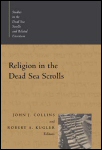
The Dead Sea Scrolls have profoundly changed the way we think about the Bible. But what is the religion found in the Scrolls themselves? This book provides a much-needed assessment of several major aspects of the religion of the Dead Sea Scrolls in light of recent publications. Eight leading experts explore the concept of divinity in the Scrolls, the Scrolls’ relation to important halakic issues, the question of Hellenistic influence in the Scrolls, and the apocalypticism and messianism specific to the Scrolls.
Contributors:
- John J. Collins
- Craig A. Evans
- Hannah K. Harrington
- Martin Hengel
- Robert A. Kugler
- Timothy H. Lim
- Eileen Schuller
- James C. VanderKam
John J. Collins is Holmes professor of Old Testament Criticism and Interpretation at Yale Divinity School and has served as president of both the Society of Biblical Literature and the Catholic Biblical Association.
Robert Kugler is Paul S. Wright Professor of Christian Studies at Lewis & Clark College, Portland, Oregon.
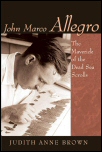
This book is the first to fully explore the life and ideas of John Marco Allegro (1923–1988), freethinker and rebel, whose work on the Dead Sea Scrolls led him to challenge the church, the team of scholars in charge of editing the Scrolls, and most conventional assumptions about the development of Christianity. As the first British member of the Scrolls editing team, Allegro shared the excitement, the insights, and the eyestrain of deciphering these invaluable ancient fragments. He made it possible for the Copper Scroll, a mysterious listing of treasure, to be opened in Manchester and did much to focus worldwide attention on the Scrolls as a whole. But he made his name—or gained his notoriety—by questioning orthodox assumptions about the Christian church’s origins and authority. Allegro went on challenging the establishment all his life, and he relished the arguments he provoked. For over thirty years he campaigned for open access to the Scrolls and for wider debate about their significance. To him it was a campaign for free speech and free opinion. Judith Anne Brown’s John Marco Allegro is a fascinating, probing, inside account of this irrepressibly original man. Making extensive use of Allegro’s letters, lecture notes, draft manuscripts, and other previously unpublished writings, Brown brings to life afresh the extraordinary discoveries and debates that began in the caves by the Dead Sea over half a century ago.
Allegro lived a fascinating life, and readers will benefit from having Brown's book available. She has provided us an important window into the early life of the field of Dead Sea Scroll studies.
—Jason Kalman, The Review of Biblical Literature
Judith Anne Brown is the daughter of John Marco Allegro, a freelance writer and editor, and an associate of the Plain Language Commission. Her work on John Marco Allegro also appears in Manchester and the Dead Sea Scrolls, edited by George J. Brooke. She lives in Derbyshire, England, with her husband and two children.
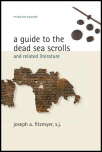
The Dead Sea Scrolls are found in many varied publications—often ordered only by publication date, rather than a more easily navigable system—making specific texts difficult to find. Joseph Fitzmyer’s guide offers a practical remedy to this dilemma. A Guide to the Dead Sea Scrolls and Related Literature starts by explaining the conventional system of abbreviations for the Scrolls. Then it helpfully lists specifically where readers can find each of the Scrolls and fragmentary texts from the eleven caves of Qumran and all the related sites, using the officially assigned numbers of the text. Fitzmyer supplies information on study tools helpful for scholars—concordances, dictionaries, translations, outlines of longer texts, and more—and briefly indicates electronic resources for the study of the Dead Sea Scrolls.
Fitzmyer’s Guide will serve as a good reference work mainly to beginners in the field of Dead Sea Scrolls scholarship. That being said, the book is very thorough and assists students with their initial research within the field. The book would serve as a useful reference for any introductory course in the Dead Sea Scrolls and should in fact be listed as a reference resource on syllabi. Fitzmyer has done a great service to the Dead Sea Scrolls scholarship by revising and updating the book: eighteen years was too long without an update with the fast pace of current scholarship in the area. This book should be updated regularly to continue to serve the academic community.
—Shayna Sheinfeld, The Review of Biblical Literature
Joseph A. Fitzmyer, S. J., is professor emeritus of biblical studies at Catholic University of America, Washington, DC.
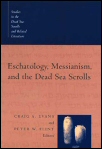
The New Testament is of prime importance for understanding early Jewish and Christian messianism and eschatology. Yet often the New Testament presumes a background and context of belief without fully articulating it. Early Jewish and Christian messianism and eschatology, after all, did not emerge in a vacuum; they developed out of early Jewish hopes that had their roots in the Old Testament. A knowledge of early Jewish literature, and especially of the Dead Sea Scrolls from Qumran, is essential for understanding the shape of these ideas at the turn of the era. In this book, the inaugural volume in the Studies in the Dead Sea Scrolls and Related Literature series, Craig Evans and Peter Flint have assembled eight essays from outstanding scholars who address this issue from a variety of angles. After an introduction by the editors, successive essays deal with the Old Testament foundations of messianism; the figure of Daniel at Qumran; the Teacher of Righteousness; the expectation of the end in the Scrolls; and Jesus, Paul, and John seen in light of Qumran.
Contributors:
- Craig A. Evans
- Peter W. Flint
- Craig C. Broyles
- Paul E. Hughes
- Martin G. Abegg, Jr.
- John J. Collins
- Craig A. Evans
- James M. Scott
- Dietmar Neufeld
Peter W. Flint is associate professor of biblical studies and codirector of the Dead Sea Scrolls Institute at Trinity Western University in Langley, British Columbia, Canada.
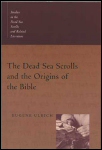
The Dead Sea Scrolls from Qumran provide the oldest, best, and most direct witness we have to the origins of the Hebrew Bible. Prior to the discovery of the Scrolls, scholars had textual evidence for only a single, late period in the history of the biblical text, leading them to believe that the text was uniform. The Scrolls, however, provide documentary evidence a thousand years older than all previously known Hebrew manuscripts and reveal a period of pluriformity in the biblical text prior to the stage of uniformity. In this important collection of studies, Eugene Ulrich, one of the world’s foremost experts on the Dead Sea Scrolls, outlines a comprehensive theory that reconstructs the complex development of the ancient texts that eventually came to form the Old Testament. Several of the essays set forth his pioneering theory of “multiple literary editions,” which is replacing older views of the origins of the biblical text. The Dead Sea Scrolls and the Origins of the Bible represents the leading edge of research in the exciting field of Scrolls studies.
There are few scholars in the field of textual criticism of the Hebrew Bible with more breadth and depth of knowledge than Eugene Ulrich. . . . His theoretical writings on the subject of text criticism have been scattered in various Festschriften and other volumes. The present volume does a welcome service in bringing together these essays into one collection. . . . It is a “must-have” on any text critic’s shelf.
—Journal of Biblical Literature
Eugene Ulrich is Professor of Hebrew Scriptures at the University of Notre Dame. He is one of the three General Editors of the Dead Sea Scrolls Publication Project (with E. Tov of Israel and É. Peuch of France), having begun working on the scrolls in 1971. He has published several volumes of critical editions of the biblical scrolls in Discoveries in the Judean Desert (Oxford University Press). Having written or contributed to eighteen books on the scrolls, he was appointed an Area Editor to Oxford's Encyclopedia of the Dead Sea Scrolls. One of the translators of the New Revised Standard Version of the Bible, he has authored numerous articles and has served as editor of the Bulletin of the International Organization for Septuagint and Cognate Studies, and served on the editorial boards of the Catholic Biblical Quarterly and Dead Sea Discoveries.
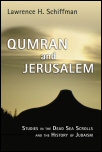
Major changes are occurring in our understanding of the fascinating texts of the Dead Sea Scrolls and their significance for the study of the history of Judaism and Christianity. One of the most significant changes—that one cannot study Qumran without Jerusalem nor Jerusalem without Qumran—is explored in this important volume. Although the Scrolls preserve the peculiar ideology of the Qumran sect, much of the material also represents the common beliefs and practices of the Judaism of the time. Here Lawrence Schiffman mines these incredible documents to reveal their significance for the reconstruction of the history of Judaism. His investigation brings to life a period of immense significance for the history of the Western world. Though many of the essays here have been previously published, all have been substantially revised. The resulting volume offers a comprehensive study that is understandable to a far wider audience than are many works on the Scrolls.
A celebrated specialist on the Dead Sea Scrolls and early Judaism, Lawrence Schiffman demonstrates that while some of the Qumran Scrolls reflect the unique thoughts of the Qumranites, others reveal the beliefs and laws of many nonsectarian Jews, including those who controlled the Jerusalem cult. In fact, the Qumranites defined themselves in contrast to the reigning priests and leaders in Jerusalem. Thus, as Schiffman demonstrates, Qumran and Jerusalem should be studied together. These essays are requisite reading for anyone interested in early Judaism and Christian origins.
—James H. Charlesworth, Princeton Theological Seminary
Lawrence H. Schiffman is Ethel and Irvin A. Edelman Professor of Hebrew and Judaic Studies and Chairman of the Skirball Department of Hebrew and Judaic Studies at New York University. His previous books include Reclaiming the Dead Sea Scrolls and From Text to Tradition: A History of Judaism in Second Temple and Rabbinic Times.
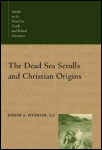
This volume by Joseph Fitzmyer, a pioneer in the field of Dead Sea Scrolls research, collects twelve of his recent studies on the Scrolls, including a new essay on Qumran messianism. Well known for his landmark work in Aramaic studies and on the Semitic background of the New Testament, Fitzmyer explores how the Scrolls have shed light on the interpretation of biblical themes and on the rise of early Christianity. All of the articles in this volume have been updated to take into account current discussions.
Scholars, teachers, and students will greatly benefit from accessing this volume from one of the foremost contemporary scholars of the early Jewish and New Testament deposit.
—Pacifica
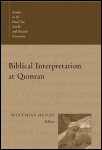
The Dead Sea Scrolls are an invaluable source of information about Jewish biblical interpretation in antiquity. This volume by preeminent scholars in the field examines central aspects of scriptural interpretation as it was practiced at Qumran and discusses their implications for understanding the biblical tradition. While many of the forms of biblical interpretation found in the Scrolls have parallels elsewhere in Jewish literature, other kinds are original to the Scrolls and were unknown prior to the discovery of the caves. These chapters explore examples of biblical interpretation unique to Qumran, including legal exegesis and the Pesher. Readers will also find discussion of such fascinating subjects as the "rewritten Bible," views on the creation of humanity, the "Pseudo-Ezekiel" texts, the pesharim, and the prophet David.
Contributors:
- Moshe J. Bernstein
- Shani Berrin
- Monica Brady
- George J. Brooke
- John J. Collins
- Peter W. Flint
- Matthias Henze
- Shlomo A. Koyfman
- Michael Segal
- James C. VanderKam
"Matthias Henze deserves congratulations for producing one of the first books to study biblical interpretation in light of the new understanding of the Bible. Our oldest evidence—the Dead Sea Scrolls—demonstrates that the Scriptures were pluriform and dynamically growing at the origins of Christianity and rabbinic Judaism. Each essay is an illumination in itself by a leading scholar who has specialized in that topic. The collection is a series of gems offering a richer and more accurate understanding of biblical interpretation in this crucial period.
—Eugene Ulrich
Matthias Henze is Watt J. and Lilly G. Jackson Associate Professor in Biblical Studies at Rice University, Houston, Texas.
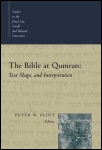
The Bible at Qumran puts the Dead Sea Scrolls to use in exploring two principal themes: the text and shape of the “Bible” at Qumran and the interpretation of these scriptures in this fascinating Jewish community. Written by leading scholars in the field, these informed studies make an important contribution to our understanding of the biblical text at a pivotal period in history.
Contributors:
- Martin G. Abegg Jr.
- James E. Bowley
- Craig A. Evans
- Peter W. Flint
- James A. Sanders
- James M. Scott
- Eugene Ulrich
- James C. VanderKam
- Robert W. Wall
- Bruce K. Waltke
These are serious and constructive pieces that will illumine and advance the ongoing study of the Dead Sea Scrolls.
—Southwestern Journal of Theology
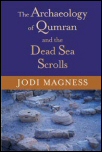
The Dead Sea Scrolls are among the most interesting and important archaeological discoveries ever made, and the excavation of the Qumran community itself has provided invaluable information about Judaism and the Jewish world in the last centuries B.C.E. Like the Dead Sea Scrolls, however, the Qumran site continues to be the object of intense scholarly debate. In a book meant to introduce general readers to this fascinating area of study, veteran archaeologist Jodi Magness here provides an overview of the archaeology of Qumran and presents an exciting new interpretation of this ancient community based on information found in the Dead Sea Scrolls and other contemporary documents. Magness's work offers a number of fresh conclusions concerning life at Qumran. She agrees that Qumran was a sectarian settlement but rejects other unconventional views, including the view that Qumran was a villa rustica or manor house. By carefully analyzing the published information on Qumran, she refines the site's chronology, reinterprets the purpose of some of its rooms, and reexamines the archaeological evidence for the presence of women and children in the settlement. Numerous photos and diagrams give readers a firsthand look at the site. Written with an expert's insight yet with a journalist's spunk, this engaging book is sure to reinvigorate discussion of this monumental archaeological find.
In the half century since Roland de Vaux excavated Qumran, the most important contributions to its archaeology have undoubtedly been made by Jodi Magness. Her erudite, painstaking, and levelheaded research has solved many of its problems. This book of hers is at once a first-rate scholarly work and a delightful read.
—Magen Broshi
Jodi Magness is the Kenan Distinguished Professor for Teaching Excellence in Early Judaism in the Department of Religious Studies at the University of North Carolina at Chapel Hill. In addition to Qumran and the Dead Sea Scrolls, her research interests include ancient pottery, ancient synagogues, and the Roman army in the East, and she has published and lectured extensively on these subjects. She has participated in twenty different excavations in Israel and Greece, including serving as codirector of the 1995 excavations in the Roman siege works at Masada.
Reviews
5 ratings
Robert Misst
8/20/2014
Tom Serrano
12/21/2013
J.R. Woods
9/3/2013

DMB
8/2/2013
Phil Niebergall
7/30/2013